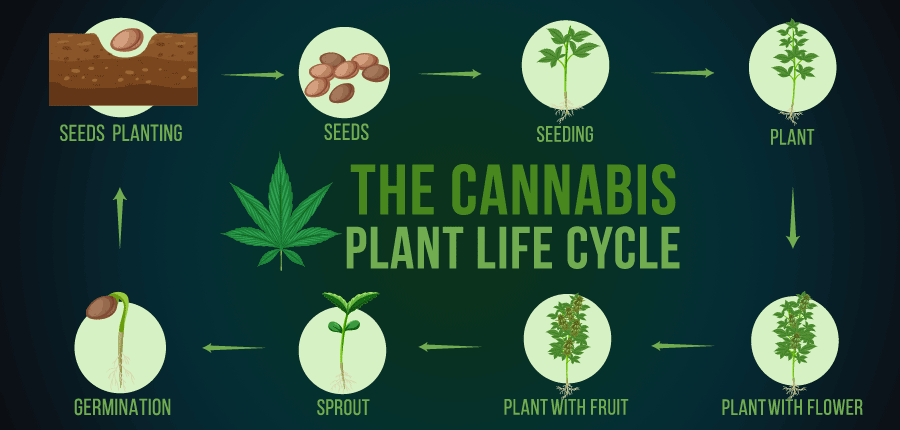


The emergence of cannabis seeds as a young plant occurs after germination, representing the second stage among the life cycle of Cannabis. At this stage, a cluster of little leaflets develops as the seedling progresses. The seedling phase, considered the most delicate and risky among the different stages of Cannabis plants, requires cultivators to exercise utmost care due to its vulnerability. This susceptibility to destruction emphasizes the need for careful handling.
Upon exposure to moisture, a seedling, representing the embryonic stage of a plant enclosed within a seed coat, commences its sprouting process. In its quest for sunlight, the emerging plant adopts an inverted growth pattern, aiming to rupture the surrounding seed casing. This phenomenon is commonly observed when seeds are cultivated beneath the soil or other materials, necessitating their upward growth towards a light source—the seedling harnesses solar energy at this stage, storing it for future growth. However, photosynthesis remains inactive during this phase, resulting in the stored energy remaining untapped. As the young plant emerges above the soil’s surface, it instinctively searches for light, initiating the photosynthetic process. Consequently, a succession of leaves begins to form, marking the beginning of the plant’s life cycle. The first set of leaves consists of a solitary leaflet, while subsequent sets produce three leaflets each.
During this stage, the young Cannabis plant doesn’t rely on external nutrients, making adding additional elements unnecessary. However, it is crucial to prioritize regular watering, ensuring a moderate frequency. Excessive watering at the seedling phase can result in excessive moisture, creating a favorable environment for the growth of molds and bacteria, which can harm the plant.
The growth rate of your Cannabis seedling can be influenced by the intensity and color of the light it receives. It is advisable to provide abundant light to your seedlings, especially as they thrive in warmer temperatures. This is because Cannabis seedlings tend to sprout more readily when exposed to higher temperatures.
For seedlings, a continuous 24-hour light cycle is necessary. Alongside warmth, consistent and uninterrupted light is vital in promoting faster development. When it comes to humidity, maintaining a level between 60% and 80% is essential to moisturize the seedlings. As mentioned, seedlings don’t require additional nutrients; plain water with a pH level ranging from 6.5 to 7.5 is sufficient.
The number of leaf fingers on the plant, also known as leaflets or lobes, typically determines the transition to the vegetative stage in Cannabis. Growers often consider the seedling stage complete once the stems have thickened and the plant has developed 3-4 leaf nodes, each consisting of multiple leaf fingers. These leaf nodes serve as a reliable indicator of the plant’s readiness to progress to the next stage.
The duration of the seedling stage can vary depending on whether you are cultivating indoors or outdoors. In indoor cultivation, where environmental conditions can be tightly controlled, the seedling phase lasts approximately 3-4 weeks. During this time, the young plants undergo significant growth and establish a strong root system, preparing them for the subsequent stages of development.
On the other hand, outdoor cultivation, influenced by natural environmental factors such as sunlight, temperature, and seasonal changes, may extend the seedling stage up to 6 weeks. The outdoor environment, with its fluctuating conditions, can impact the growth rate of the plants, leading to a slightly longer seedling phase. This extended period allows the seedlings to adapt to external conditions and develop robust structures before transitioning to the vegetative stage.
Once your young Cannabis plants start developing a sturdy and resilient root system, indicating their readiness, it is time to consider transplanting them. However, despite the strength gained by their roots, it is crucial to approach transplantation with caution due to the delicate nature of seedlings. These fragile plants are highly susceptible to damage, and any mishandling can hinder their growth and overall health.
It is essential to handle the seedlings with great care during the transplantation process. Avoid harm or disturbance to the fragile stems, leaves, and roots. This can be achieved by gently holding the seedlings and supporting them from the base, ensuring minimal stress on the plant. These precautionary measures will help safeguard the young plants’ well-being and promote their continued growth.
When transitioning the seedlings to their new growing environment, strive for a smooth and seamless transfer. Prepare the new planting containers or beds in advance, ensuring they are appropriately sized and filled with well-draining soil or growing medium. Create a suitable hole or space for each seedling, ensuring it accommodates the root system without bending or tangling the roots.
Once the seedlings are placed in their new homes, gently backfill the surrounding soil or medium, providing ample support to the plant while avoiding excessive pressure on the roots. Water the transplanted seedlings thoroughly but gently, allowing the moisture to penetrate the soil and encourage root establishment in the new environment.
By exercising caution, providing a gentle touch, and ensuring a smooth transition during transplantation, you can significantly increase the chances of successful growth and overall vitality for your young Cannabis plants.
For optimal lighting conditions, it is advised to position the light source approximately 5 cm above your seedlings, preventing excessive heat exposure that could harm them. Consistency in lighting is crucial, but be cautious not to place the light too far away as it may cause the plants to stretch and become more susceptible to tipping over. When using high-intensity discharge (HID) or other heat-generating light sources, finding the right distance is important—around 80 cm above the seedlings—to provide sufficient light without excessive heat. Conducting a heat test beforehand can help determine the appropriate placement. Utilizing LED lights with a cooled spectrum is recommended for efficient and effective lighting. Implementing an 18/6 light schedule, with 18 hours of light followed by 6 hours of darkness, can further enhance your seedlings’ healthy growth and development.
Providing excessive supplements and nutrients to seedlings is one of the common mistakes made by some cultivators, especially beginners. It’s important to understand that Marijuana seedlings do not require additional nutrients for their growth. They simply need water with a well-balanced pH level, adequate moisture, and sufficient light. During this growth stage, it is advisable to allow the seedlings to thrive naturally instead of overwhelming them with elements at such an early phase of their life.
After a week or two, you can consider introducing feeding to your plants, but using only half of the recommended dosage is crucial. Please do so to avoid the demise of your seedlings.


Best Selling
Feminized Seeds
Regular Seeds
Customer Help
WE SELL MARIJUANA SEEDS IN THE USA

Are You 18 Or Over?
YesOr
No By clicking yes, you certify that you are over 18. By using this website, you agree to our legal disclaimer.